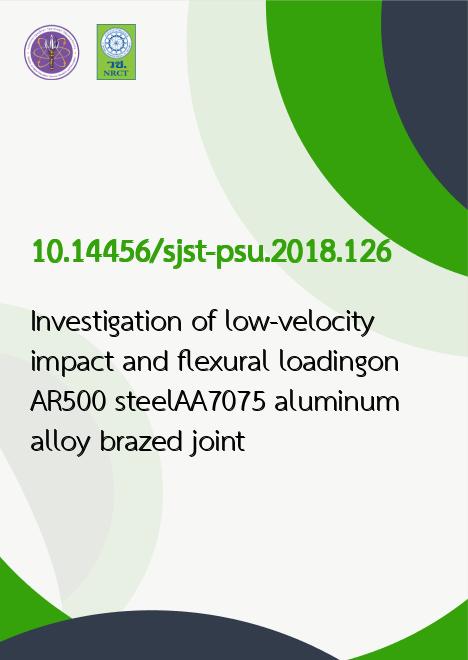
|
Investigation of low-velocity impact and flexural loadingon AR500 steel/AA7075 aluminum alloy brazed joint |
|---|---|
| รหัสดีโอไอ | |
| Creator | 1. Mohd Najib Muhamed 2. Mohd Zaidi Omar 3. Shahrum Abdullah 4. Zainuddin Sajuri 5. Wan Fathul Hakim Wan Zamri |
| Title | Investigation of low-velocity impact and flexural loadingon AR500 steel/AA7075 aluminum alloy brazed joint |
| Publisher | Research and Development Office, Prince of Songkla University |
| Publication Year | 2561 |
| Journal Title | Songklanakarin Journal of Science and Technology |
| Journal Vol. | 40 |
| Journal No. | 5 |
| Page no. | 1034-1038 |
| Keyword | brazing, metal joining, impact strength, dissimilar metals |
| URL Website | http://rdo.psu.ac.th/sjstweb/index.php |
| ISSN | 0125-3395 |
| Abstract | This paper presents the results of an experimental study to evaluate the damage and failure mode of AR500steel/AA7075 aluminum alloy brazed joint panels caused by an impact load. Drop weight tests were conducted on AR500steel/AA7075 aluminum alloy brazing joint panels to study their response and performance under impact loading. The use ofsteel and aluminum joints is becoming increasingly popular since they are well known for excellent weight, strength, andstiffness properties and this condition makes them the material of choice for lightweight applications in the automotive industry.In this work, AR500 steel/AA7075 aluminum alloy plates were fabricated by the torch brazing method with Al-Si-Zn base as thefiller metal and evaluated for their impact performance and flexural strength by conducting drop weight tests under low velocityimpacts and a three point bend test. Experimental results showed that the AR500 steel/AA7075 aluminum alloy brazed jointpanel flexural strength was 615 N and the low velocity impact strength was 1569 N. The experiment caused delamination of thejoint at the aluminum and filler metal region. The Al-Si-Zn filler bonding capability on the AA7075 aluminum was lowcompared to the AR500 steel. However, it is capable of joining these dissimilar metals. The data obtained from this study shouldassist researchers and designers to better understand damage and failure behaviour of panels made of dissimilar metals which willresult in components with a better design. This is particularly so in the aspect of the crashworthiness properties of structuralcomponents, especially in static, quasi-static, and dynamic loadings. |
